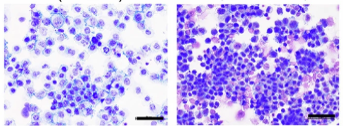Since the Food and Drug Administration approved the targeted therapy drug venetoclax in 2020, it has become a first-line treatment for acute myeloid leukemia (AML), a blood cancer. Unfortunately, some AMLs have proven resistant to venetoclax—including those caused by mutations in the RAS gene family, which account for 10-20% of all cases.

without vs. with RAS mutations
A new study from Damon Runyon scientists Eirini Papapetrou, MD, PhD, Piro Lito, MD, PhD, Elli Papaemmanuil, PhD, and Elvin Wagenblast, PhD, at Icahn School of Medicine at Mount Sinai explains why RAS-mutant leukemias behave differently, and may offer a clue to overcoming their treatment resistance.
The team, led by Dr. Papapetrou, applied cutting-edge genomic tools to patient-derived leukemia models to investigate how RAS mutations drive leukemia growth and influence the tumor’s response to therapy. They discovered that RAS mutations invariably occur in blood stem cells that have already acquired cancerous mutations, giving rise to a distinct population of RAS-mutant leukemia stem cells. The descendants of these stem cells behave differently from other leukemia cells. Notably, as the team found, RAS-mutant cells exhibit changes in the proteins that control apoptosis, or cell death, granting them resistance to drugs like venetoclax.
These findings, which underscore that there is no one-size-fits-all approach to treating leukemia, bring us a step closer to a personalized medicine approach.
“For patients with RAS mutations, treatment with venetoclax might not be effective and could even worsen their condition,” Dr. Papapetrou said. “For these patients, providers should consider a combination of therapies that include new RAS inhibitors, which could improve treatment results.”
This study was published in Nature.







